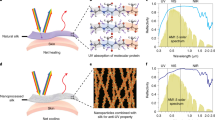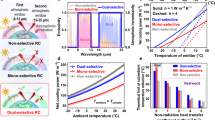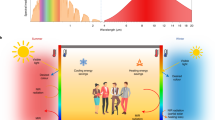Abstract
Radiative cooling textiles dissipate human body heat without any energy input, providing a sustainable means for personal thermal management. However, there is still a lack of textile materials to support efficient cooling in varied outdoor and indoor environments. Here we show a polyoxymethylene (POM) nanotextile design that not only achieves selective emission in the atmospheric window (8–13 μm) but also shows transmission in the remaining mid-infrared wavebands and reflection of sunlight (0.3–2.5 μm). As a result, the POM textile achieves efficient radiative human body cooling both outdoors (under sunny and cloudy conditions) and indoors (0.5–8.8 °C lower than typical textiles). Moreover, the textile design shows favourable wearability and outperforms its commercial counterparts when used as protective clothing. The POM material provides both indoor and outdoor human body cooling and introduces new possibilities in the rational design of next-generation smart textiles and other applications supporting sustainability.
This is a preview of subscription content, access via your institution
Access options
Access Nature and 54 other Nature Portfolio journals
Get Nature+, our best-value online-access subscription
$29.99 / 30 days
cancel any time
Subscribe to this journal
Receive 12 digital issues and online access to articles
$119.00 per year
only $9.92 per issue
Buy this article
- Purchase on Springer Link
- Instant access to full article PDF
Prices may be subject to local taxes which are calculated during checkout




Similar content being viewed by others
Data availability
All data are available in the main text or the supplementary materials. Source data are provided with this paper.
References
Mitchard, E. T. A. The tropical forest carbon cycle and climate change. Nature 559, 527–534 (2018).
Office of Energy Saver. Heating and cooling US Department of Energy https://www.energy.gov/energysaver/heating-and-cooling
Yin, X., Yang, R., Tan, G. & Fan, S. Terrestrial radiative cooling: using the cold universe as a renewable and sustainable energy source. Science 370, 786–791 (2020).
Munday, J. N. Tackling climate change through radiative cooling. Joule 3, 2057–2060 (2019).
Fan, S. & Li, W. Photonics and thermodynamics concepts in radiative cooling. Nat. Photonics 16, 182–190 (2022).
Peng, Y. & Cui, Y. Advanced textiles for personal thermal management and energy. Joule 4, 724–742 (2020).
Fang, Y., Chen, G., Bick, M. & Chen, J. Smart textiles for personalized thermoregulation. Chem. Soc. Rev. 50, 9357–9374 (2021).
Hsu, P. C. et al. Radiative human body cooling by nanoporous polyethylene textile. Science 353, 1019–1023 (2016).
Cai, L. et al. Spectrally selective nanocomposite textile for outdoor personal cooling. Adv. Mater. 30, 1802152 (2018).
Peng, Y. et al. Nanoporous polyethylene microfibres for large-scale radiative cooling fabric. Nat. Sustain. 1, 105–112 (2018).
Leroy, A. et al. High-performance subambient radiative cooling enabled by optically selective and thermally insulating polyethylene aerogel. Sci. Adv. 5, eaat9480 (2019).
Hsu, P. C. & Li, X. Q. Photon-engineered radiative cooling textiles. Science 370, 784–785 (2020).
Kim, G., Park, K., Hwang, K. J. & Jin, S. Highly sunlight reflective and infrared semi-transparent nanomesh textiles. ACS Nano 15, 15962–15971 (2021).
Zeng, S. et al. Hierarchical-morphology metafabric for scalable passive daytime radiative cooling. Science 373, 692–696 (2021).
Zhu, B. et al. Subambient daytime radiative cooling textile based on nanoprocessed silk. Nat. Nanotechnol. 16, 1342–1348 (2021).
Cai, L. L. et al. Temperature regulation in colored infrared-transparent polyethylene textiles. Joule 3, 1478–1486 (2019).
Alberghini, M. et al. Sustainable polyethylene fabrics with engineered moisture transport for passive cooling. Nat. Sustain. 4, 715–724 (2021).
Iqbal, M. I. et al. Radiative cooling nanofabric for personal thermal management. ACS Appl. Mater. Interfaces 14, 23577–23587 (2022).
Song, Y. N., Lei, M. Q., Lei, J. & Li, Z. M. Spectrally selective polyvinylidene fluoride textile for passive human body cooling. Mater. Today Energy 18, 100504 (2020).
Kim, G. et al. Black textile with bottom metallized surface having enhanced radiative cooling under solar irradiation. Nano Energy 82, 105715 (2021).
Chen, Z., Zhu, L., Li, W. & Fan, S. Simultaneously and synergistically harvest energy from the sun and outer space. Joule 3, 101–110 (2019).
Raman, A. P., Anoma, M. A., Zhu, L., Rephaeli, E. & Fan, S. Passive radiative cooling below ambient air temperature under direct sunlight. Nature 515, 540–544 (2014).
Shi, N. N. et al. Keeping cool: enhanced optical reflection and radiative heat dissipation in Saharan silver ants. Science 349, 298–301 (2015).
Chen, Z., Zhu, L., Raman, A. & Fan, S. Radiative cooling to deep sub-freezing temperatures through a 24–h day-night cycle. Nat. Commun. 7, 13729 (2016).
Zhai, Y. et al. Scalable-manufactured randomized glass-polymer hybrid metamaterial for daytime radiative cooling. Science 355, 1062–1066 (2017).
Mandal, J. et al. Hierarchically porous polymer coatings for highly efficient passive daytime radiative cooling. Science 362, 315–318 (2018).
Bhatia, B. et al. Passive directional sub-ambient daytime radiative cooling. Nat. Commun. 9, 5001 (2018).
Li, T. et al. A radiative cooling structural material. Science 364, 760–763 (2019).
Goldstein, E. A., Raman, A. P. & Fan, S. H. Sub-ambient non-evaporative fluid cooling with the sky. Nat. Energy 2, 17143 (2017).
Chen, Y. et al. Colored and paintable bilayer coatings with high solar-infrared reflectance for efficient cooling. Sci. Adv. 6, eaaz5413 (2020).
Wang, T. et al. A structural polymer for highly efficient all-day passive radiative cooling. Nat. Commun. 12, 365 (2021).
Zhou, Y. et al. A polydimethylsiloxane-coated metal structure for all-day radiative cooling. Nat. Sustain. 2, 718–724 (2019).
Li, D. et al. Scalable and hierarchically designed polymer film as a selective thermal emitter for high-performance all-day radiative cooling. Nat. Nanotechnol. 16, 153–158 (2021).
Jeng, H. A. & Swanson, J. Toxicity of metal oxide nanoparticles in mammalian cells. J. Environ. Sci. Health A 41, 2699–2711 (2006).
Lin, W. S. et al. Toxicity of nano- and micro-sized ZnO particles in human lung epithelial cells. J. Nanopart. Res. 11, 25–39 (2009).
Keerthana, S. & Kumar, A. Potential risks and benefits of zinc oxide nanoparticles: a systematic review. Crit. Rev. Toxicol. 50, 47–71 (2020).
Han, D., Ng, B. F. & Wan, M. P. Preliminary study of passive radiative cooling under Singapore’s tropical climate. Sol. Energy Mater. Sol. Cell 206, 110270 (2020).
Godbole, R. V. Destabilization of clouds by radiative cooling. Mon. Weather Rev. 101, 496–500 (1973).
Huang, J. Y., Lin, C. J., Li, Y. & Huang, B. L. Effects of humidity, aerosol, and cloud on subambient radiative cooling. Int. J. Heat Mass Tran. 186, 122438 (2022).
Aili, A. et al. Selection of polymers with functional groups for daytime radiative cooling. Mater. Today Phys. 10, 100127 (2019).
Kennedy, E. R. & Ashley, K. Fourier-transform infrared spectrometry attenuated total reflectance study of the reaction of pentanal and propanal with 2-(hydroxymethyl)piperidine. Appl. Spectrosc. 46, 266–272 (1992).
Bognitzki, M. et al. Nanostructured fibers via electrospinning. Adv. Mater. 13, 70–72 (2001).
Kongkhlang, T. et al. Electrospun polyoxymethylene: spinning conditions and its consequent nanoporous nanofiber. Macromolecules 41, 4746–4752 (2008).
Hoyt, T., Arens, E. & Zhang, H. Extending air temperature setpoints: simulated energy savings and design considerations for new and retrofit buildings. Build. Environ. 88, 89–96 (2015).
Hoyt, T., Lee, K. H., Zhang, H., Arens, E. & Webster, T. Energy savings from extended air temperature setpoints and reductions in room air mixing. In Proc. 13th International Conference on Environmental Ergonomics (The Univ. Wollongong, 2009).
Acknowledgements
This work is supported by the National Key Research and Development Program of China (2020YFA0210702, 2020YFC2201103) and the National Natural Science Foundation of China (22075163, 51872156).
Author information
Authors and Affiliations
Contributions
R.Z., X.W., J.Z. and J.L. conceived the idea. X.W. and J.L. designed the models and experiments. X.W. and J.L. performed the material preparation and characterization with the help of Q.J., W.Z., B.W., R.L., S.Z., F.W., Y.H., Y.Z. and P.L.; X.W. and Q.J. performed the modelling work. X.W. wrote the paper. R.Z. supervised the project. All the authors provided discussion and comments.
Corresponding authors
Ethics declarations
Competing interests
The authors declare no competing interests.
Peer review
Peer review information
Nature Sustainability thanks the anonymous reviewers for their contribution to the peer review of this work.
Additional information
Publisher’s note Springer Nature remains neutral with regard to jurisdictional claims in published maps and institutional affiliations.
Supplementary information
Supplementary Information
Supplementary Texts 1–13, Supplementary Figs. 1–49 and Supplementary Tables 1–3.
Supplementary Video 1
Process of qualitative test of air permeability with the SET-type POM sandwiched between air (upper) and water (lower).
Supplementary Video 2
Result of permeability test of the SET-type POM. The continuous bubble transmittance and effective isolation of water and air shows the remarkable breathability and high waterproofness of our POM textile.
Supplementary Video 3
Sunny outdoor infrared video of human body wearing POM-based protective clothing tested in Beijing, China (40°0′33″ N, 116°20′0.6″ E, 16 May 2022).
Supplementary Video 4
Cloudy outdoor infrared video of human body wearing POM-based protective clothing tested in Beijing (17 May 2022).
Supplementary Video 5
Indoor infrared video of human body wearing POM-based protective clothing tested in Beijing (17 May 2022).
Supplementary Video 6
Sunny outdoor infrared video with another large-size POM-based protective clothing (Beijing, 7 October 2022).
Supplementary Video 7
Cloudy outdoor infrared video with another large-size POM-based protective clothing (Beijing, 9 October 2022).
Supplementary Video 8
Indoor infrared video with another large-size POM-based protective clothing (Beijing, 6 October 2022).
Source data
Source Data Fig. 1
Simulated data for the skin surface temperatures of different RC textile models.
Source Data Fig. 2
Diameter size distribution and spectral response data for POM textile.
Source Data Fig. 3
Statistical source data for thermal measurements.
Source Data Fig. 4
Statistical source data for POM-based protective clothing.
Rights and permissions
Springer Nature or its licensor (e.g. a society or other partner) holds exclusive rights to this article under a publishing agreement with the author(s) or other rightsholder(s); author self-archiving of the accepted manuscript version of this article is solely governed by the terms of such publishing agreement and applicable law.
About this article
Cite this article
Wu, X., Li, J., Jiang, Q. et al. An all-weather radiative human body cooling textile. Nat Sustain 6, 1446–1454 (2023). https://doi.org/10.1038/s41893-023-01200-x
Received:
Accepted:
Published:
Issue Date:
DOI: https://doi.org/10.1038/s41893-023-01200-x
This article is cited by
-
A dual-selective thermal emitter with enhanced subambient radiative cooling performance
Nature Communications (2024)
-
Electrospinning of nanofibres
Nature Reviews Methods Primers (2024)
-
Bio-inspired and Multifunctional Polyphenol-Coated Textiles
Advanced Fiber Materials (2024)
-
Preparation of thermoresponsive cotton fabric by grafting P(MEO2MA-co-OEGMA475-co-GMA) polymer for personal thermal management
Cellulose (2024)
-
Versatile and Comfortable Janus Fabrics for Switchable Personal Thermal Management and Electromagnetic Interference Shielding
Advanced Fiber Materials (2024)



